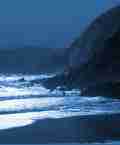 |
Search the site:

CONNEMARA & THE BURRENSome of our party (on Ben Lettery) called for the provision basket. It was little short of treason against the majesty of Nature, to fix those eyes on rolls and cold beef, which ought to have been directed to one of the noblest views of Cunnemarra.First Connemara, that is the Twelve Bens, the Maamturks and the Benchoonas. All three ranges are in west Galway and separated from the mountains of south Mayo only by Killary Harbour. This is a small but highly varied area, much of it bereft of the evidence of humankind, yet not all that remote, and in all very rewarding. The Burren in County Clare is quite far away from Connemara and is included in this region only because it fits in even more incongruously elsewhere than it does here. The Twelve Bens (routes 92 to 94, 104), also incorrectly called "the Twelve Pins", a magnificent cluster of steep-sided, bare, rocky quartzite "haystacks", cover a tiny area (less than ten kilometres/six miles in any direction). Some of the Bens are in the Connemara National Park and contain the nucleus of a recently introduced herd of red deer. Though they rise to only 730 metres/2,395 feet at Binn Bhan/Ben Baun (route 93), the seventeen or so peaks in this range appear to be very much higher and the long, steep descents and re-ascents between peaks make most walks within them quite arduous. Navigational problems are not as acute as might appear at first glance - the narrow ridges virtually exclude all but the most gross errors, though these, if they occur, could involve lengthy and difficult retreats. Because of the lack of vegetation on the tops and slopes, these hills are exceptionally dry underfoot. In contrast, the valleys are normally very wet and should be avoided. The most popular routes are high-level circuits of the tight horseshoes surrounding the valleys (routes 92 to 94). Like the Twelve Bens, the Maamturks (routes 95 to 97), are a bare, rocky quartzite range rising to a somewhat lower height, Binn idir an Da Log (703 metresl2,307 feet) (route 95) being the highest peak. Like the Bens, they are generally dry underfoot and command marvellous views. Here the resem-blance ends because, as has been observed: "The Maamturks are the Bens, straightened out and with the tops sheared off" . The Maamturks form two shallow arcs (the smaller is named on the maps as part of Joyce Country), in all about twenty kilometres/twelve miles long. It is this near-linear configuration which makes looped walks difficult to devise. The tops form a virtual plateau slashed by a set of steep-sided passes which are heart-breakingly arduous to traverse on routes along the spine of the range. This plateau and the numerous unwanted cairns in places make navigation particularly difficult in poor visibility, so that the excellent mapping is of a great help. Careful study on the map of the details of the proposed route is advisable. The Western Way runs through a gap in the Maamturks and along its flanks; though it is not waymarked at present, it is useful in forming the lowland section of looped walks. The Maamturks Walk, considered by many to be the toughest of Ireland's marathon walks, takes place every year in Mayor June; the route is usually north-west to Leenane. The Benchoonas (routes 98, 99, 101) are the hills between Killary Harbour and the N59. A small area of modest hills rising no higher than 601 metres/l,973 feet at Garraun, they nonetheless provide great geological interest and command lovely views. For days of low cloud there is an easy and scenic walk along the south shore of Killary Harbour south-east of the youth hostel (route 101). The next 'Connemara & the Burren' extract can be found here : Part 2
|
[ Back to Top ]
All Material © 1999-2009 Irelandseye.com and contributors
